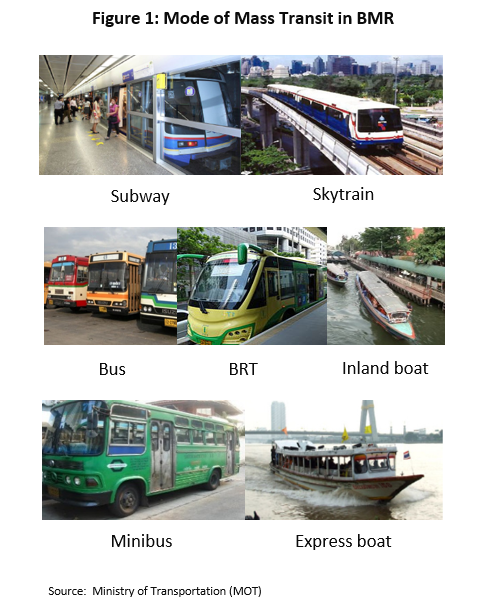The mass rapid transit sector over the next three years is likely to experience growth in line with expansion in the use of mass transit services due to a greater numbers of potential customers coming within the service areas of rapid mass transit networks, increasing demand for the use of mass transit lines to travel between business districts and areas in outer Bangkok, and changing consumer behavior which is favoring transport options that are quick, convenient and regular.
Increases in income for service operators come from (i) passenger fares; (ii) the exploitation of commercial rights held for activities carried out in and around stations and on carriages; and (iii) maintenance services. However, operators’ increasing income might not be fully realized in 2019 as new lines and the extension of mass rapid transit system would be opened from late 2019 onwards.
Overview
Mass transit systems are a form of public rail transport[1]in which the Thai government has made ongoing investments as a means of solving problems with congestion in the Bangkok Metropolitan Region (BMR)[2]. Bangkok’s mass rapid transit system is thus a public utility or public service provided by the government for commuters and travelers, who may choose between these and other means of public transport in the BMR, such as buses, shared taxis, minivans, the Bus Rapid Transit system, the suburban-urban rail system, and express and inland boats.
Mass rapid transit systems use rolling stock that travels at mid to high speed (80-160 kph) on tracks which run separately from other forms of transport (i.e. there is no interaction between mass rapid transit systems and other transport modalities). Tracks may run underground, above ground, or on elevated platforms, depending on the environment in which the system is being constructed. Urban rail, light trams, monorail, and light and heavy trains may all be used in such a system.
The first public mass rapid transit line to operate was the Chalerm Prakiet Skytrain line, which improved connections between inner Bangkok and a wider area of central Bangkok[3]. This opened for operations in late 1999 and since then new lines have continued to be added or extended such that at present,
the city’s mass rapid transit system comprises 5 lines, 86 stations, and 121.53 kilometers of track (Figure 2). The entire system is composed of the following:
- The Bangkok Mass Transit System (BTS) is composed of 2 lines.
- The BTS Sukhumvit (Light Green) Line runs for a distance of 34.83 kilometers between 31 stations. The first section of this, opened in 1999, was the On Nut-Mo Chit line, which covers 17 kilometers and 17 stations. In 2011, a further 5.25 kilometers and 5 stations were added for the On Nut-Bearing section. In 2017, the extension of the Southern Green Line was added, comprising the 12.58 kilometers of the Bearing-Samut Prakan section, together with Samrong station. This 2017 addition is part of a larger extension involving a total of 9 stations and with a line length of 12.58 kilometers, which has been opened since April 2019.
- The BTS Silom (Dark Green) Line has a length of 14 kilometers and includes 13 stations. The first part of this line ran between the National Stadium and Saphan Taksin. This section was opened in 2004, included 7 stations and had a total track length of 6.5 kilometers. Following its opening, over the period 2009 to 2013, the Saphan Taksin-Wong Wian Yai-Bang Wa line was constructed, adding a further 7.5 kilometers of track and 6 stations.
- The Metropolitan Rapid Transit (MRT) also has 2 components.
- The MRT Chalerm Ratchamongkhon (or Blue) Line runs through 18 stations between Hua Lamphong and Bang Sue and has a total length of 20 kilometers. It was opened in 2004. Later, the extension of Bang Sue and Tao Poon was opened in 2017 with a length of 1.2 kilometers, linking the Blue and Purple lines and making them part of a single transport network.
- The Chalong Ratchadham (or Purple) Line connects Khlong Bang Phai and Tao Poon. This line is 23 kilometers long and includes 16 stations. The line began operations in 2016 but in August 2017, an extension connecting Bang Sue and Tao Poon was added, linking the Blue and Purple lines and making them part of a single transport network.
- The Airport Rail Link (ARL) is a project to connect Suvarnabhumi Airport to public transport facilities in the inner-city area. It is composed of two lines:
- The ARL City Line runs through 8 stations over the 28.5 kilometers between Phayathai and Suvarnabhumi. On this track, which was opened in 2010, trains operate at a speed of 90-120 kph.
- The ARL Express Line covers 25.7 kilometers between Makkasan and Suvarnabhumi Airport. This section of the track is non-stop so trains can travel at 130-160 kph, thus providing a convenient and rapid link between the airport and a central location. (Currently, however, the track is closed for maintenance and improvements.)
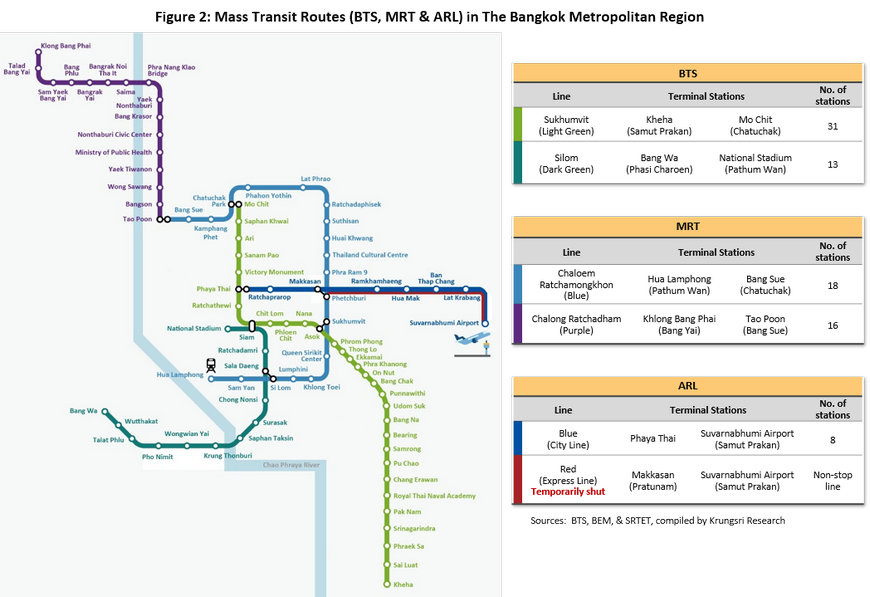
Private sector mass rapid transit operators in Thailand need to acquire concessions from the government. When applying for these concessions and considering performance, service operators will take into account the economic situation and the cost of living, which have direct consequences on the number of passengers which they can expect. In addition, two further aspects of the conditions attached to the concession/agreement need to be considered.
- The type of investment. Investments in mass transit systems require extremely large amounts of money and the repayment period may be very long. Because of this, investments may be made jointly between the public and private sectors and these joint ventures may be of two types:
- Public-private partnerships (PPP) [4] share investments and operations as specified in the project details. The division of responsibilities[5] may be in one of three forms (Table 1). (i) the government or the state-owned enterprises (SOEs) is responsible for provision of the site but all other works are undertaken by the private sector including the foundation works, civil engineering works, electrical and machinery systems and all operation management system (i.e. provide rolling-stock, manage daily operations, and be responsible for maintenance), or (ii) the government or the SOEs is responsible for the provision of the site and the foundation works, civil engineering works but the private sector will supply all the electrical and machinery systems, and all operation management system or (iii) the government or the SOEs is responsible for provision of the site, the foundation works, civil engineering works, electrical and machinery systems, while the private sector operators will invest in all operation management system.
- Public sector comparator (PSC) setups involve public sector providing all procedures of the investment and then contracting the private sector to manage all operation system. The private sector operator will make a payment in every period as agreed in the contract but contracts for the provision of services may be terminated if targets are not met or if losses are incurred for an extended period.
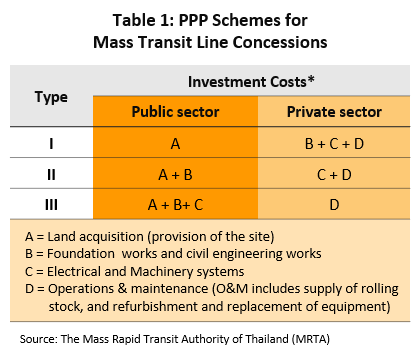
Choosing private sector partners for investment in mass transit systems specifies private sector operators should bid for concessions for each line. Each line is the responsibility of a route developer (either the government itself or an agency or other organization acting on behalf of the government) and currently, there are three of these: (i) the Bangkok Metropolitan Administration (BMA), (ii) The Mass Rapid Transit Authority of Thailand (MRTA), and (iii) The State Railway of Thailand (SRT). The private sector operator which receives the concession to operate on a line is termed the ‘service operator’ and there are currently also three of these: (i) the Bangkok Mass Transit System Public Company (BTSC), (ii) the Bangkok Expressway and Metro Public Company Limited (BEM), and (iii) the SRT Electric Train Company (SRTET).
- Apportioning revenue between the private sector and the SOEs in the PPP project will be according to the specifics of the contract[6] and will come from user charges -- collecting fares from passengers and service charges for commercial activities from renters, excluding income from maintenance services which the government hires service sector to operate.
- Net cost concession: Here, service operators will collect all incomes and will make payments to the SOE as specified in the contract. In this case, service operators have the opportunity to gain more incomes if passenger fares or incomes from management of commercial activities in stations. are greater than expected.
- Gross cost concession: In this case, the SOE will collect all incomes and make payments to private sector operators in every period as agreed in the contract. This; thus, removes risk to operators of fluctuating incomes and allows private sector partners to reduce their exposure to risk, which is particularly important when a line first decade opens and the level of income is uncertain, with loss-making thus a possibility.
- Modified gross cost concession: In this situation, the SOE collects income and makes two forms of payments to operators. (i) As with the gross cost scheme, a payment is made in every period as agreed in the contract but in addition (ii) additional payments (bonus) may be made if income from operations increases by a greater than expected amount. But no lines are presently operating on a PPP modified gross cost basis.
The BMR mass transit system is currently benefiting from significant upgrades to its capacity. This is being carried out in line with the Thailand Transport Infrastructure Development Plan (2015-2022), which has the goal of using the public transport system to solve Bangkok’s longstanding traffic problems and, at the same time, to reduce transportation costs by creating a unified, interconnected mass transit network[7] that will initially be composed of 10 different lines (Figure 3). Investments in these, as with the 5 lines currently are in operation in the following details: the two Green Lines (BTS) and the Blue Line (MRT) are structured on the basis of public-private partnerships (PPPs) net cost; the Purple Line operates on a PPP gross cost basis; and the ARL is organized on the PSC model (Table 2).
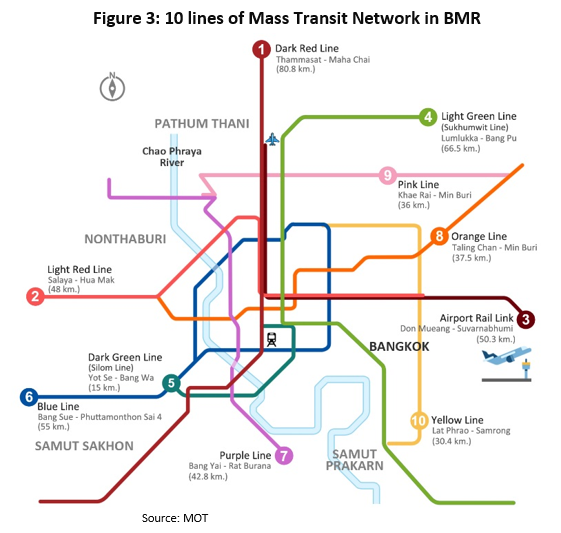
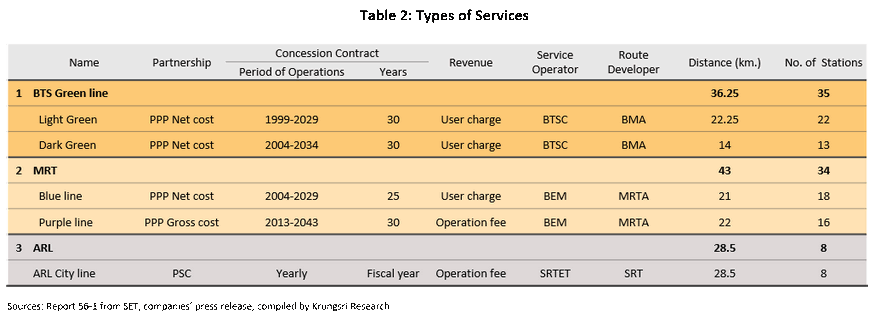
Situation
Data from public mass transit service providers in the BMR on the average number of passengers using their services per day (Figure 4) show that as a proportion of the total, journeys taken by rail mass transit services (the BTS, the MRT and the ARL) is steadily rising. Partly, this is because travel by these services which are convenient and quick, delivering travelers directly to the city center, and partly because of the increasing number of extensions and stations that are being opened. But uptake of bus services offered by the BMTA, the proportion is tending to decline.
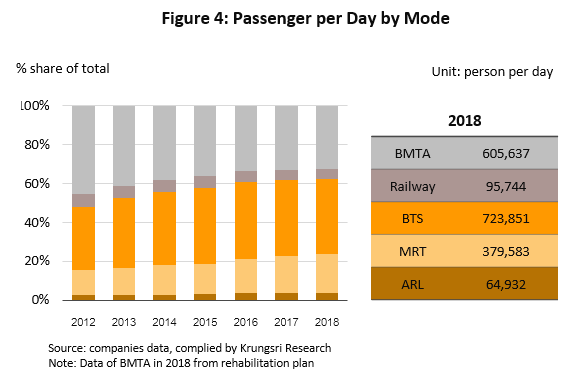
Over the past five years, the number of travelers on all lines of the BMR mass rapid transit system has steadily increased (Figure 5). It is noticeable from the data that during the initial period in which a line operates, only relatively small numbers of passengers will use the service but once investments have been made in increasing the number of extensions and interchanges with other lines, or after a period of time has passed, the number of passengers using the services rose. An increase in passenger numbers, locations, size of areas and the number of stations and size for commercial areas then points to future income for the service operators. Fares and maintenance service fee for electrical system, which are part of revenues, will be supervised by the government and changes and are subject to terms of concession contracts.
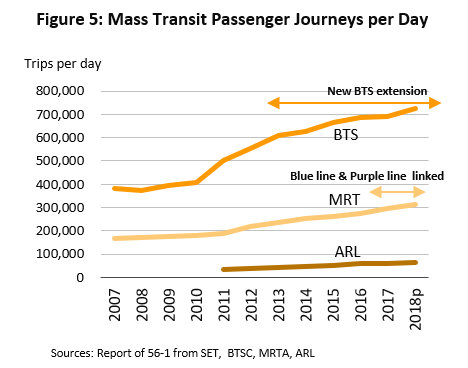
The situation for service operators in 2018: Operators invested to provide more services and increase passengers such as expansion of space in carriages, an increase in the number of carriages, revamping carriage interiors and increase in frequency of trains. Despite this, though, complaints about mass transit services and slow improvements of those services that have been made (and which have not yet met customer expectations) may help to explain why average daily passenger-journeys have in fact fallen during some periods. Details are given below (Table 3).
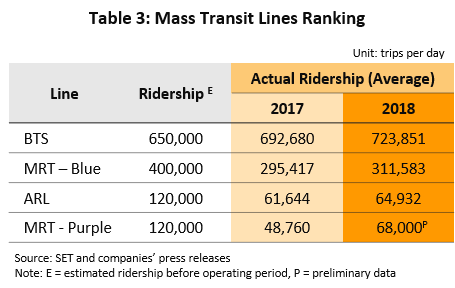
- BTS Silom (Dark Green) and Sukhumvit lines: In 2018, use of these lines exceeded their target; for the year, an average of 723,851 daily passenger-journeys were made, which represented growth of 4.5% YoY. This positive situation is explained by the fact that the BTS carries more passengers than do other lines because it is the main line serving Bangkok’s Central Business District (CBD)[8]. A large number of passengers commute to this area, and these are typically student- or working-age passengers who travel on lines that are longer than elsewhere, and this therefore means that these lines service a larger pool of passengers. In addition, testing with the Samrong-Samut Prakan extension began at the end of 2018 and this too is helping to boost passenger numbers.
- The MRT Blue and Purple lines: Linking the Blue and Purple lines to create a single, unified route in 2016 helped to make travel between Bangkok and Nonthaburi significantly more convenient and this then lifted passenger numbers on these two lines. The Blue Line thus carried a daily average of 311,583 passenger-journeys (up 5.5% YoY), while use of the Purple Line jumped by 39.5% YoY to a daily average of 68,000 passenger-journeys. However, despite these increases in usage, both lines are still operating at levels that have failed to meet their targets by a significant margin.
- The ARL: This recorded an average of 64,932 passenger-journeys per day, and although this represented growth of 5.3% YoY, usage was still significantly below expectations.
When considering service operators’ performance, both the opportunities for its development and the risks to it differ according to the type of investment and the period over which it has been made.
- Two lines on Bangkok’s mass transit system are operated that have undertaken to operate on a net cost concession basis. (i) The BTS Green Line commenced operations over a decade ago. This line connects to the CBD and passenger numbers are in excess of the targets. Therefore, possibilities exist to increase income, both from fares and from development of commercial activities in stations. (ii) The MRT Blue Line is currently exposed to a certain amount of risk because, although they have improved following the opening of connections with the Purple Line, its usage rates have not been as high as anticipated. However, it should be remembered that the line is still in its first decade of operations and extensions and connections to the wider mass transit network are still being made and so future opportunities for service operators to increase income will present themselves as these improvements are made.
- In contrast, companies that have signed agreements specifying gross cost concession or PSC terms, respectively the operators of the MRT Purple Line and the ARL, which are hired by the government or the SOEs to operate services. Fixed levels of compensation for the provision of their services are paid as agreed and so they are exposed to only low levels of risk of loss of income but the flip side of this is that they may miss opportunities to increase their income, should passenger numbers increase to a level that is higher than anticipated or the contract may be terminated if the performance is lower than targeted.
Industry Outlook
It is expected that the number of travelers using the mass rapid transit system will grow during 2019-2021 and this will underpin rising incomes for operators, supported by
- Residential projects have expanded along and near mass transit lines. Information compiled by AREA and Krungsri Research shows that over 2017-2018, a total of 140,000 new condominiums were brought to the market and a further 75,000 are expected for 2019, giving a total of roughly 210,000 new units. Of total new units, around 150,000 units are completed and become available during adjacent to mass transit lines and become available during 2019-2021 (figure 6). This supply of new condominiums may be used as a proxy for estimating the increasing number of customers over 2019-2021 and in this case, the total number of customers should grow by 54,000 units, or 110,000 individuals[9].
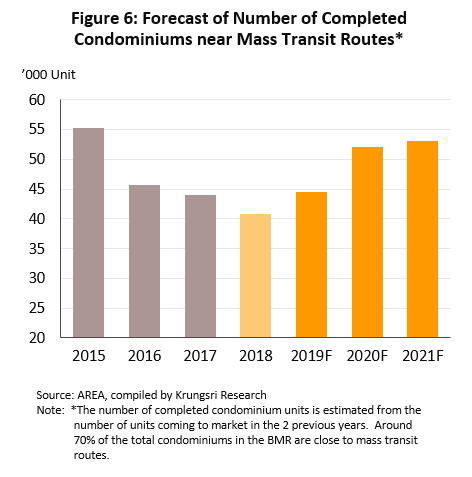
- The requirement for quick and reliable transport options is building due to ever-mounting problems with increasing traffic congestion, a problem that is only worsening as the number of vehicles on the roads of the Bangkok Metropolitan Region (BMR) steadily increases. Indeed, average traffic speeds during rush hour are low across the BMR but within the CBD, they are even worse (Figure 7). Moreover, when data from the Office of Transport and Traffic Policy and Planning on congestion and a survey of the average speed of private vehicles in the Bangkok region in the morning and evening for the five-year period 2012-2016 is compared with the most recent data (i.e. that from 2017), it is clear that the situation is continuing to decline (Table 4). As stated, the increasing size of the vehicle fleet and the attendant rise in the severity of traffic jams are to blame for this situation, though it can also be expected that this will act as a stimulus to consumers to change their behavior and, where there is an opportunity, to switch to using mass transit systems as new lines or extensions become operational.
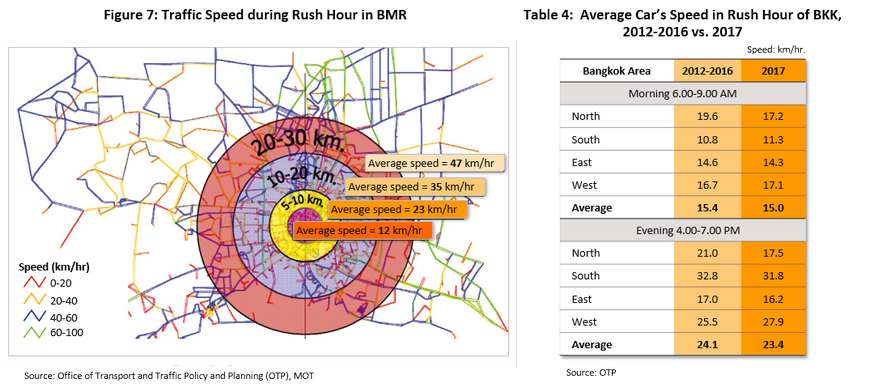
- The government plans to continue expanding the coverage of the network and this will improve not just the distance covered by the lines and the connections between them. The number of stations and the walkways linking them to nearby buildings and commercial areas and other buildings near the stations will also continue to increase and this will improve incomes for operators. Over the next three years the lines which will be expanded (Figure 8) are as follows:
The BTS northern Green Line extension (Mo Chit-Saphan Mai-Khu Khot)
- runs for 18.2 kilometers and will include 16 stations. Testing of the Mo Chit-Ha Yaek Lat Phrao section will begin in August 2019.
The MRT Blue Line extension has 2 parts:
- The Hua Lamphong-Lak Song (Bang Kae) section, which runs for 14 kilometers and through 11 stations, should be in operation in September 2019.
- The Bang Sue-Tha Phra section, which is slightly shorter at 13 kilometers and includes 10 stations, is expected to be opened in March 2020.
The Red Line (on the commuter rail) is also getting two extensions and these should be open to the public in the beginning of 2021:
- The Bang Sue-Taling Chan section (Light Red Line) is 15.2 km long and covers 3 stations.
- The Bang Sue-Rangsit section (Dark Red Line) is 26.3 km long and includes 10 stations.
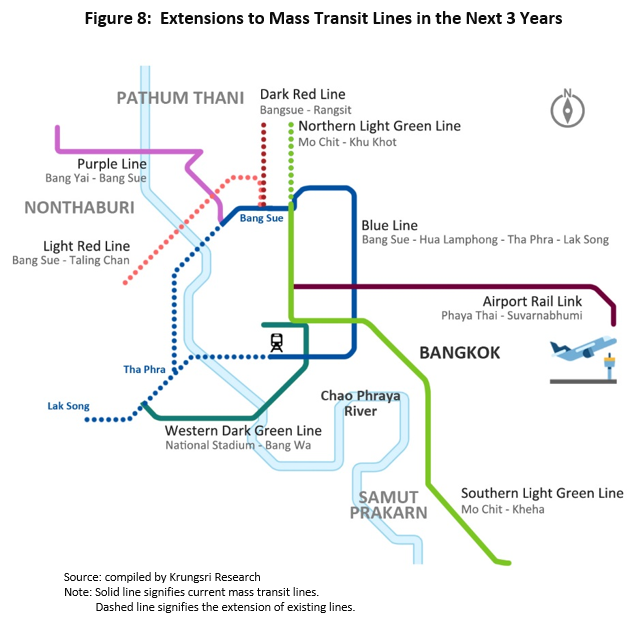
The extension of the Green Line and Blue Line in 2019-2020 are expected to increase operators’ fare incomes from both existing and new lines, from maintenance work, and from any rights operators have for commercial operations in and around stations and on rolling stock during the concession period. This latter might include advertising, telecommunication, and the management of commercial property.
In addition, to develop and to ensure the comprehensive coverage of the mass transit network, the government is attempting to speed up the process for evaluating joint public-private communications ventures, especially for mass transit lines, through the PPP Fast Track[10]. Thus, in the coming period, in addition to the extensions to existing lines in the BMR described above, new lines will also be opened. At the moment, construction work on these is underway and in the future, these will be connected to the main mass transit network.
- The new mass transit lines will include: 2 sections of the Red Line, the Bang Sue-Rangsit section (26.3 kilometers long) and the Bang Sue-Taling Chan section (15.2 kilometers); the Khae Rai-Min Buri Pink Line (34.5 kilometers); the Lat Phrao-Samrong Yellow Line (30.4 kilometers); and the Thailand Cultural Centre-Min Buri Orange Line (21.2 kilometers).
- Extensions to existing lines will include: the Hua Lamphong-Lak Song (Bang Khae) and Bang Sue (Tao Poon)-Tha Phra extensions to the Blue Line (with a combined length of 27 kilometers); and the Bearing-Samut Prakan (12.58 kilometers) and Mo Chit-Saphan Mai-Khu Khot (18.2 kilometers) extensions to the Green Line.
- Extensions and spurs on new lines that will connect to existing lines will include: the two-station Pink Line extension to Muang Thong Thani (2.8 kilometers); and the Yellow Line Ratchadaphisek-Ratchayothin (2.6 kilometers) extension that will link the Green and Blue lines.
The government has a policy to continuing expand the service areas of mass transit system. This indicates a significant opportunity for Thailand to invest in connecting between new routes and extension lines to build out of the interconnected mass transit network. Also, service operators would receive substantial income arising from related services.
Krungsri Research’s view:
Business structure is strong as it is necessary public facilities which is co-investment projects between public and private sectors under the long-term contracts for more than 25 years. Revenue sharing and terms and conditions of concession help support service operators’ profitability.
Service providers will benefit from rising passenger numbers, the latter being lifted by: (i) residential property developments that are being built alongside or nearby mass transit lines; (ii) greater demand for quick and reliable travel options, as inner-city traffic conditions worsen; and (iii) the expansion of the transport network, which will grow to cover a greater portion of the population and so steadily be accessible by more people. Given this, income for operators can be expected to grow steadily, this coming from a mix of fares, fees for the provision and maintenance of services for electrical systems, and income from the management of commercial properties, and thus players who already have the rights to operate mass transit systems should see their opportunities for generating profits grow.
[1] Mass transit systems are defined as transport systems that move large numbers of passengers along fixed routes according to predetermined schedules. These systems emphasize the provision of services to the population in the area served, making ease of access a priority. In Thailand, land-, air- and water-based mass transit systems are available, although land-based services (including rail) are the primary means of travel. These services include (i) buses, both standard types and minibuses, (ii) rail transport, including suburban railways (operated by the State Railway of Thailand) and the MRT (a joint public-private initiative), and (iii) water-based transport, which is operated by the private sector (e.g. by Chao Phraya Express Boat Co. Ltd. and Family Transport (2002) Co. Ltd.) but which is under the control of the state.
[2] Overall traffic commute time index surveyed by the Numbeo showed that Bangkok is one of five cities where has the worst traffic congestion in South East Asia.
[3] According to its administrative arrangements, Bangkok can be divided into three zones. (i) The inner zone is composed of Phra Nakhon, Pom Prap Sattru Phai, Samphanthawong, Pathum Wan, Bang Rak, Yan Nawa, Sathon, Bang Kho Laem, Dusit, Bang Sue, Phayathai, Ratchathewi, Huai Khwang, Khlong Toei, Chatuchak, Thonburi, Khlong San, Bangkok Noi, Bangkok Yai, Din Daeng and Watthana. (ii) Further out is the middle or central region, which includes Phra Khanong, Prawet, Bang Khen, Bang Kapi, Lat Phrao, Bueng Kum, Bang Phlat, Phasi Charoen, Chom Thong, Rat Burana, Suan Luang, Bang Na, Thung Khru, Bang Khae, Wang Thonglang, Khan Na Yao, Saphan Sung and Sai Mai. (iii) Finally come the outer, suburban districts of Min Buri, Don Muang, Nong Chok, Lat Krabang, Taling Chan, Nong Khaem, Bang Khun Thian, Lak Si, Khlong Sam Wa, Bang Bon and Thawi Watthana.
[4] Currently, investment in mass transit by rail transportation system development is one of four types of works which are allowed private operation to join under the Private Participation in State Undertaking Act of 2013 in accordance with the Public-Private Partnerships Strategic Plan B.E.2016-2021.
[5] Private operators are allowed to engage in foundation works, civil engineering works, installation of electrical and machinery system, operation management to provide rolling-stock, manage daily operation, operate commercial activities in and around stations, and maintenance electrical and machinery system. Any private operators will be granted the right under the concessions only in specific works they invest; for example, if private sectors have engaged in all project, they will receive all incomes from demolition, construction and civil engineering works, installation and maintenance, operation management, fares, commercial activity management on carriages, in stations and surrounding areas (advertising, space rental for selling products, telecommunication services).
[6] The division of returns specified in contracts may include additional conditions, such as that the share of income may increase after a set period of time (every 10 or 15 years, for example) or that the burden of costs should be eased (e.g. that maintenance costs should be cut at a fixed rate every 5 years.)
[7] The mass rapid transit master plan for the Bangkok Metropolitan Area (or M-Map) determines the development of mass transit system in BMR over the period 2010 to 2029.
[8] CBD is an area that is dominated by business activities and which is physically located in the center of the urban region, since this is easy to travel to. The CBD is usually densely populated and so the expansion of buildings tends to occur vertically. In Bangkok, the CBD comprises Silom, Sathorn, Surawong, Rama 4, Ploenchit, Wireless Road, Sukhumvit (Sois 1-71) and Asoke.
[9] Of total sold units, it is forecast that 60% will be bought by owner-occupiers, with the remaining 40% being bought as investments or for resale. It is assumed that each unit will contain at least two individuals.
[10] The PPP Fast Track is a process for speeding up assessment of projects under which, in a number of different ways, the private sector jointly invests in government projects. Under the PPP Fast Track, the time it takes to evaluate PPP initiatives has been cut to 9 months from the earlier 25 months set in the relevant legislation (i.e. the Private Participation in State Undertakings Act, 1992).





.webp.aspx)

